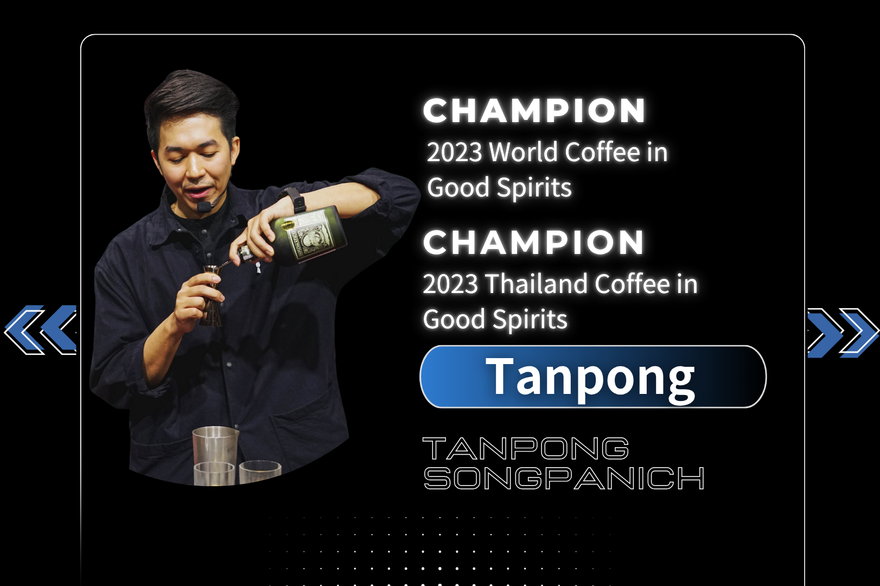【Who Is Sherry? — World Brewer Cup Champion from Taiwan】
Sherry Hsu (徐詩媛), the 2022 World Brewers Cup (WBrC) Champion from Taiwan, has spent the years since her win turning her competition techniques into a practical brewing framework—translating complex extraction variables into approachable, repeatable steps for everyday brewers.
At the World of Coffee event, Sherry brewed the same coffee using the same parameters, changing only one variable: the grinder. She prepared side-by-side brews with the Femobook A68 and A4Z to demonstrate how grinder choice alone can lead to noticeably different flavor notes in the cup.
She also showcased two coffees with distinct flavor profiles—one floral, the other fruit-forward—to demonstrate how the right combination of grinder, split-temperature water, and pouring strategy can precisely extract the intended flavors.
【Femobook A4Z vs. A68: Grinder Comparison & Flavor Performance】
Before brewing, Sherry introduced the basic features of the two grinders:
-
The A4Z is a wireless electric grinder [1], fitted with 1Zpresso ZP6 burrs [2]
-
The A68 features a 68mm conical burr set [3]
She also pointed out that each grinder tends to emphasize different flavor profiles in the cup:
-
For coffees with delicate floral notes, she prefers the A4Z, as it brings out florals and results in a delicate, elegant, and clean cup.
-
For fruit-forward coffees, she reaches for the A68, as it tends to boost sweetness.

Frank
Femobook's Editor
1. The A4Z is a rechargeable grinder with a user-replaceable battery module—no need to discard the entire grinder due to battery degradation over time.
2. The A4Z is fitted with ZP6 burrs, exclusively licensed from 1Zpresso. Designed for pour-over brewing, the ZP6 is known for its ultra-low fines and exceptional clarity—and was the grinder used by 2023 WBrC Champion Carlos Medina.
3. The A68 is a plug-in electric grinder.
【A4Z vs. A68: Side-by-Side Brew for Flavor Comparison】
To demonstrate how different grinders can influence flavor expression, Sherry brewed two coffees using two grinders and two water temperature strategies.
Brew 1: The A4Z Brings Out Floral Notes in a Colombian Washed Geisha
In the first demo, she used a Colombian Washed Geisha with floral notes, grinding with both the A68 and the A4Z, keeping all parameters and steps identical to isolate the grinder’s impact. The only variable was the grinder itself.
She used a split-temperature approach—starting with a 75 °C bloom to preserve delicate floral aromas, then moving to 93 °C pours to enhance sweetness and balance later in the brew.
When tasting the two brews side by side, some participants preferred the second cup. Sherry revealed that it was brewed with the A4Z, and highlighted its clean, elegant profile and how well it brought out the coffee’s floral character.
Brew 2: The A68 Enhances Sweetness in a Colombian Natural Geisha
For the second brew, Sherry used a Colombian Natural Geisha with vibrant fruity notes, along with hints of winey and fermented character. Once again, she kept all parameters the same—except for the grinder—to let the audience experience how the A68 and A4Z highlight different flavor qualities.
Given the coffee’s fruit-forward profile, she used a split-temperature approach: 93 °C in the early and middle stages to extract fruitiness and sweetness, then 75 °C in the final pour to avoid over-extraction.
Sherry also shared that a higher level of fines tends to increase perceived sweetness—but can reduce the clarity of florals. She chooses between the A68 and A4Z depending on the bean and the flavor goal [1].
For fruit-forward or more complex coffees, she often prefers the A68, which produces more fines than the A4Z. While this can soften floral clarity, the extra fines enhance sweetness—helping round out acidity as the cup cools.

Frank
Femobook's Editor
1. The A4Z is designed for pour-over brewing and produces the least amount of fines among all Femobook grinders.
The A68 is a versatile all-round grinder, suitable for espresso, moka pot, pour-over, AeroPress, French press, and more.
【Brewing Recipes from WBrC Champion Sherry】
Pour-Over Recipe 1 - Floral Profile
| Parameter | Setting |
|---|---|
| Coffee | 14 g, Washed Geisha from El Diviso, Colombia |
| Water | 210 g |
| Temperature | 75 °C / 93 °C |
| Grinder | Femobook A68 (setting 170) & A4Z (setting 125) for side-by-side comparison |
| Recommended Grinder |
A4Z Sherry finds that this coffee’s floral notes are best expressed with the A4Z, resulting in a delicate, elegant, and clean cup. |
Brewing Process
00:00 → 75 °C, 1st pour to 50 g , bloom for 30 seconds
00:30 → 93 °C, 2nd pour to 100 g, using a spiral pour
→ 93 °C, 3rd pour to 150 g, using a center pour
→ 93 °C, 4th pour to 210 g, using a center pour
Total brew time: ~1 minute 50 seconds
Sherry's note: Floral aromas tend to release too early at high temperatures. This split-temperature approach helps preserve floral notes while building sweetness and balance in the cup.
Pour-Over Recipe 2 – Fruity Profile
| Parameter | Setting |
|---|---|
| Coffee | 14 g, Natural Geisha from Guacobia, Colombia |
| Water | 210 g |
| Temperature | 93 °C / 75 °C |
| Grinder | Femobook A68 (setting 170) & A4Z (setting 125) for side-by-side comparison |
| Recommended Grinder |
A68 Sherry finds that this coffee's fruity profile—with subtle winey and fermentation notes—is best expressed with the A68, resulting in enhanced sweetness in the cup. |
Brewing Process
00:00 → 93 °C, 1st pour to 50 g, bloom for 30 seconds
00:30 → 93 °C, 2nd pour to 150 g using a spiral pour
→ 75 °C, 3rd pour to 210 g using a center pour
Total brew time: ~1 minute 40 seconds
Sherry’s note: This temperature design uses 93 °C early on to highlight fruity notes and sweetness, then drops to 75 °C for the final pour to reduce extraction and keep the finish clean.
【Pour-Over Techniques from WBrC Champion Sherry】
During her demonstration, Sherry brewed while breaking down her pour-over techniques into approachable principles. Instead of simply copying her recipe, the audience could learn how to build their own, based on extraction logic, bean characteristics, and personal flavor preferences.
1. How Does Split-Temperature Brewing Affect Extraction?
Sherry explained that adjusting water temperature at different pouring stages—based on the coffee’s character—helps extract and preserve desirable aromatics while boosting sweetness and overall balance.
-
For floral coffees: Blooming at a lower temperature (70–80 °C) helps preserve delicate floral aromas that might otherwise release too early. She then uses 93 °C water to increase extraction and build sweetness and balance.
-
For fruit-forward coffees: She starts with high temperatures (93 °C) in the early and middle stages to bring out fruitiness, finishing with a lower temperature (75 °C) to reduce extraction and keep the final cup clean.
2. Choosing Between Floral Clarity and Sweetness: Grinder Trade-Offs
Sherry explained that increasing the proportion of fines (within a reasonable range) tends to enhance sweetness—but at the cost of floral clarity.
So when choosing between the A4Z and A68, she focuses on the flavor profiles of the coffee bean.
The A4Z produces fewer fines and helps highlight delicate floral notes with a delicate, clean, and elegant cup profile.
In contrast, the A68 creates more fines, which contributes to greater sweetness.
When working with coffees that show both floral and fruity characteristics, she tends to favor the A68—because the added sweetness helps prevent the acidity from becoming sharp as the coffee cools.
3. Why Use More Water During the Bloom?
Sherry shared that during the bloom phase, she typically uses a coffee-to-water ratio of 1:3 or higher. This ensures that all the grounds are evenly saturated (setting the stage for extraction in the following pours).
4. Dialing In: Start with the Cupping Grind Size
When testing a new grinder, Sherry typically starts by dialing in to the SCA cupping grind size and brews a cup from there. If the flavor intensity feels too low, she grinds finer—then makes further adjustments based on how the cup tastes.
As a general rule, light roasts work better with a finer grind, while darker roasts tend to benefit from a coarser grind.
【Choosing Between the A68 and A4Z: Start with Your Flavor Goal】
To demonstrate how grinder choice alone can shift the cup profile, Sherry brewed side-by-side comparisons using the same coffee, parameters, and method—with only the grinder changed.
She noted that the A4Z is particularly suited for coffees with delicate floral characteristics, producing a cup that’s refined, elegant, and clean.
On the other hand, for fruit-forward coffees, she reaches for the A68, which helps enhance sweetness.
However, increasing sweetness often comes at the expense of floral clarity—due to the A68’s higher level of fines. This trade-off is a key factor in her decision when choosing between the two grinders.
Sherry’s final advice: Start by identifying your flavor target—do you want a clean, floral cup, or are you chasing fruitiness and sweetness?
Once that’s clear, fine-tune your brew using split-temperature water and grind settings.
-
For florals and an elegant, clean profile → A4Z [1]
-
For enhanced sweetness → A68 [2]

Frank
Femobook's Editor
1. A4Z: Fitted with ZP6 burrs, the A4Z is purpose-built for pour-over brewing. It produces minimal fines and delivers a clean, high-clarity cup.
2. A68: A versatile, all-round grinder designed to support a wide range of brewing methods—including espresso, pour-over, and more.









